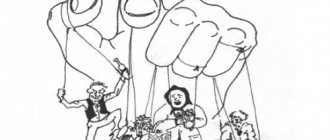Concept
Identification is identifying oneself with another person, members of a group, or a character in a movie or book. In other words, the concept of identification in psychology can be considered as likening oneself to someone.
Identification is divided into two types: primary and secondary. The primary one can be attributed to the formation of the child’s personality, going through the process of identification. First, the baby identifies itself with its parents.
Secondary identification is identifying oneself with people who are not parents.
People react to others with different facets of their psyche. Therefore, the most popular definition is social psychology as a science that tries to understand and explain how the thoughts, feelings and behavior of individuals are influenced by the actual, imagined or presumed presence of others. A person's reaction to the presence of others manifests itself in a wide variety of effects.Group effects
- these are the mechanisms of group functioning, through which group processes are carried out and group states are achieved. They are means that ensure the integration of individual actions in joint group activities and communication. Here we look at 15 major group effects:
- The effect of social facilitation (inhibition).
- The "group membership" effect.
- Ringelmann effect.
- "Synergy" effect.
- The "groupthink" effect.
- The "conformity" effect.
- The effect of “fashion” (imitation).
- "halo" effect.
- The "group favoritism" effect.
- The effect of “group egoism”.
- The "pendulum" effect.
- "Wave" effect.
- Pulsar effect.
- "Boomerang" effect.
- The "us - them" effect.
The effect of social facilitation.
The effect is associated with an increase in dominant responses in the presence of others.
This effect was discovered by Norman Triplett in 1897. Triplett's experiment consisted of studying the results of the influence of the competition situation on the change in the speed of a cyclist and comparing them with the results obtained in a single race. Triplett found that cyclists clocked better times when they were racing against each other rather than against a stopwatch, and concluded that the presence of others encouraged people to perform more vigorously.
The effect of the presence of others can either increase or decrease a person's motivation. For example, the presence of others reduces the effectiveness of a person’s activity when learning nonsense syllables, going through a maze, and solving complex multiplication problems.
Increased social arousal promotes a dominant response. However, when the solution algorithm is known and the person does not see the correct answer, social arousal, i.e., an unconscious reaction to the presence of others, complicates mental operations (analysis, synthesis, establishing cause-and-effect relationships) and leads to an incorrect decision. A person’s attention switches from solving a problem to the people around him. When solving simple problems, the reaction is innate or well learned. The presence of other people turns out to be a powerful stimulant and contributes to the correct decision.
Social psychologist D. Myers believes that the determining factors of this type of reaction are:
- the number of people around. The impact of others increases with their number. A person becomes much more excited when surrounded by a large number of people;
- relationships of sympathy or antipathy within a group;
- the importance of surrounding people for a person;
- the degree of spatial proximity between people. Social arousal is stronger the closer people are to each other.
The effect of group membership.
The English psychologist McDougall in 1908, in his book “Social Psychology,” among other instincts, identified the feeling of belonging to a group of people.
English psychologists G. Tezfel and J. Turner in the late 70s studied the process of an individual’s awareness of belonging to a group, calling it “group identification.” They created a theory of social identity, the main provisions of which are as follows: a person, identifying himself with a group, strives to evaluate it positively, thus raising the status of the group and his own self-esteem.
Group identity is an attitude toward belonging to a specific group. Like any attitude, it consists of three components - cognitive, emotional and behavioral - and regulates a person’s behavior in a group.
Cognitive
The component consists in a person’s awareness of belonging to a group and is achieved by comparing one’s group with other groups according to a number of significant characteristics. Thus, the basis of group identity is the cognitive processes of cognition (categorization) of the surrounding social world.
Emotional
component is inextricably linked with the cognitive component. The emotional side of identity lies in the experience of belonging to a group in the form of various feelings - love or hate, pride or shame.
Behavioral
The component appears when a person begins to react to other people from the perspective of his group membership, and not from the perspective of an individual, from the moment when the differences between his own and other groups become noticeable and significant for him.
Ringelmann effect.
As the number of members increases, the average individual contribution to the group work decreases.
This effect was discovered by V. Mede’s student Max Ringelman. He found that the collective performance of a group does not exceed half of the sum of the performance of its members, i.e., group members are actually less motivated and put in less effort when performing joint actions than when performing individual actions. M. Ringelman experimented with lifting weights in groups and individuals. It turned out that if the productivity of one person is taken to be 100%, then two people together on average will lift a weight that is not twice as much, but is only 93% of the total weight lifted by two separately working people. The “efficiency factor” of a group of three people will be equal to 85%, and of eight people - only 49%. Ringelman proposed a formula for determining the average individual contribution of participants in groups of different sizes:
C = 100 - 7 * (K-1),
where C is the average individual contribution of participants; K is the number of group members.
B. Latain in 1979 described the phenomenon of a non-interfering witness. After conducting a series of various experiments, he proved that the sheer number of witnesses to a tragic incident prevents any of them from providing assistance. An accident victim is less likely to get help if a large number of people are watching to see them suffer. The following pattern was discovered: the likelihood of receiving help is higher if a person is in a small group, and much lower if he is surrounded by a large number of people.
Factors of social laziness
are:
- the presence of individual responsibility for the results of their work. The higher the responsibility, the lower the social laziness;
- group cohesion and friendships. People in groups mess around less if they are friends rather than strangers;
- group size. The larger the group size, the higher the social laziness;
- cross-cultural differences. Members of collectivistic cultures exhibit less social loafing than members of individualistic cultures;
- gender differences. Women are less socially lazy than men.
"Synergy" effect.
This is the additional intellectual energy that arises when people unite into an integral group and is expressed in a group result that exceeds the sum of individual results, that is, it meets the requirement 1+1>2.
This group effect was studied by V. M. Bekhterev. In his works and the works of M.V. Lange, it was established that a group’s success at work can indeed exceed the individual success of individuals.
This is manifested not only in the intellectual sphere, but also in increasing the observation of people in the group, the accuracy of their perception and assessments, the amount of memory and attention, the effectiveness of solving relatively simple problems that do not require complex and coordinated interaction. However, when solving complex problems, when logic and consistency are necessary, “especially gifted people,” in Bekhterev’s terminology, can exceed the group average achievements.
The effect of “synergy” is most clearly manifested during “brainstorming” - a “brainstorming”, when the group needs to propose many new ideas without critical analysis and logical comprehension.
Groupthink effect.
It is a way of thinking that people acquire in situations where
the search for agreement becomes so dominant in a cohesive group that it begins to overpower a realistic assessment of possible alternative actions.
The discovery of this phenomenon and the invention of the term “groupthink,”
or
“groupthink,” belongs to the American psychologist Irving Janis. The “groupthink” effect occurs in a situation where the criterion of truth is the united opinion of the group, which is opposed to the opinion of an individual. When group members are faced with the threat of disagreement, disputes and conflicts, they try to reduce group cognitive dissonance and eliminate the resulting negative feelings, trying to find a solution that suits everyone, even if this solution is not objective and reasonable from the point of view of each individual member groups.
Typically, for a group involved in such a decision-making strategy, the search for consensus becomes so important that group members voluntarily give up any doubts and opportunities to look at the problem with a new, original, unconventional view. Individual members of the group can even turn into a kind of “thought guards”, quickly recording and harshly punishing any dissent.
Thus, a person is dependent on the group in his contacts with the outside world; in the overwhelming majority of cases, he is inclined to yield to the group. Even a person's sensory information can be distorted by social pressure.
The effect of conformity.
In 1956, Solomon Ash coined the term "conformity" and described the results of his experiments with a dummy group and naive subjects. A group of seven people was asked to participate in an experiment to study the perception of the length of segments. It was necessary to determine which of the three segments drawn on the poster corresponded to the reference one. At the first stage, dummy subjects alone gave, as a rule, the correct answer. At the second stage, the group gathered together and the group members gave a false answer, unknown to the naive subject. With their categorical opinions, the group members exerted pressure on the subject’s opinion. According to Ash, 37% of his subjects listened to the group's opinion and showed conformity. The study of the conformity effect is very popular in social psychology. There are several conditions for the emergence of conformity:
- personality type:
people with low self-esteem are more susceptible to group pressure than people with high self-esteem; - group size:
people show the greatest degree of conformity when they are faced with the unanimous opinion of three or more people; - group composition:
conformity increases if, firstly, the group consists of experts, secondly, the group members are significant people for the person, thirdly, the group members belong to the same social environment; - the trap of “groupthink”
among people; - cohesion:
the greater the degree of cohesion of a group, the more power it has over its members; - status, authority:
people with the highest status also have the greatest influence, it is easier for them to exert pressure, they are more often obeyed; - the presence of an ally:
if a person defending his opinion or doubting the unanimous opinion of the group is joined by at least one ally who gave the correct answer, then the tendency to submit to group pressure decreases; - public response:
People show a higher level of conformity when they have to speak in front of others, and not when they write down their answers in their notebooks. Having expressed an opinion publicly, people, as a rule, continue to adhere to it.
The degree of conformity increases if the task is difficult or the subject feels incompetent.
D. Myers names three reasons for conformist behavior. First, the persistent and stubborn behavior of other people can convince a person that his initial opinion is wrong. Secondly, a group member consciously or unconsciously strives to avoid punishment, reproach, condemnation, or ostracism from the group for disagreement and disobedience. Thirdly, the uncertainty of the situation and the lack of clarity of information contribute to a person’s orientation towards the opinions of other people; they become specific and clear sources of information.
In group interaction, the effect of conformity plays a significant role, since it is one of the mechanisms for making a group decision.
Fashion effect (imitation).
Imitation is one of the main mechanisms of group integration. In the process of group interaction, group members develop common standards and behavioral stereotypes, adherence to which emphasizes and strengthens their membership in the group. In external expression, such stereotyping can even result in a uniform (for example, a military uniform, a businessman’s business suit, a doctor’s white coat), which shows others what social group this or that person belongs to, what norms, rules and stereotypes govern his behavior. People are more likely to follow the example of someone who is similar to them than someone who is unlike them.
The imitation effect underlies any learning and contributes to people’s adaptation to each other, the consistency of their actions, and their preparedness to solve a group problem. It is close to the conformism effect. However, if with conformism the group somehow puts pressure on its member, then with imitation, following group requirements is voluntary.
"halo" effect.
This is
the influence on the content of knowledge, opinions, and personality assessments of a specific attitude that one person has in relation to another.
The “halo” effect, or “halo effect,” is a phenomenon that occurs in people’s perception and evaluation of each other in the process of communication.
The halo effect occurs under the following conditions:
- lack of time.
A person does not have time to get to know another person in detail and carefully consider his personal qualities or the situation in which he finds himself; - information overload.
A person is so overloaded with information about various people that he does not have the opportunity or time to think in detail about each individual; - the insignificance of another person.
Accordingly, a vague, indefinite idea of the other, his “halo” arises; - stereotype of perception.
It arises on the basis of a generalized idea of a large group of people to which a given person belongs according to certain parameters; - brightness, originality of personality.
One personality trait catches the eye of others and pushes all other qualities into the background. Physical attractiveness is often such a characteristic.
In a negative sense, this effect manifests itself in downplaying the merits of the object of perception, which leads to prejudice in relation to it on the part of the perceiver. Prejudice is a specific attitude of subjects based on information about the negative qualities of an object. Such information, as a rule, is not checked for accuracy and reliability, but is taken for granted.
The effect of group favoritism.
This is
the tendency to favor in some way members of one's own group over members of another group.
The effect of group favoritism is based on the “us and them” effect and, as it were, establishes a “line of demarcation” between those people who, according to some criteria, are perceived as “insiders”, and those who, according to the same criteria, are perceived as “strangers”.
Here are some patterns of the mechanism of group favoritism:
- the effect of group favoritism is more pronounced in cases where the criteria for comparison based on the results of activities and the specifics of relationships with other groups are very significant for the group, i.e. when the groups are in a situation of competition with each other;
- group favoritism manifests itself more strongly in relation to those groups whose criteria for comparison with the activities of which are not only significant for the group, but also correspond to its own criteria, i.e. in this case, the possibility of clear, unambiguous comparability of groups arises;
- membership in a group turns out to be more important than interpersonal similarity: people more often prefer “their own”, although they are not similar to themselves in personal qualities, and refuse to prefer “strangers”, although they are similar to them in views, interests, and personal characteristics;
- group members tend to explain the possible success of their group by intra-group factors, and its possible failure by external factors, i.e. if a group achieves success, then it attributes this result to itself (its professionalism, favorable socio-psychological climate, business qualities of leaders and etc.), but if a group fails, then people look for those to blame outside the group and try to shift the blame onto other groups.
The effect of group egoism.
This is the direction of group interests, goals and norms of behavior against the interests, goals and norms of behavior of individual members of a group or the whole society. The goals of the group are achieved by infringing on the interests of its individual members, to the detriment of the interests of society. Group egoism manifests itself when the goals, values of the group, and the stability of its existence become more important than the individual, more significant than the goals of society. Then the individual is usually sacrificed to the integrity of the group and completely submits to its requirements and standards of behavior. The effect of group egoism can play a very negative role in the further life of the group and the fate of its individual members.
The "pendulum" effect.
This is
a cyclic alternation of group emotional states
of a sthenic and asthenic nature. The intensity of manifestation and the temporary extent of emotional states are determined by the conditions and events of their joint activity that are significant for group members.
The experimental-emotional potentials of the group were studied by Russian psychologist A. N. Lutoshkin. Mood depends on several factors:
- time of day and day of the week:
at the end of the working day and week, the mood of workers worsens as fatigue accumulates; - features of the psychological structure
of the group, leadership processes; - level of labor discipline in the group:
the higher the labor discipline, the better the mood and emotional state of the group members; - the existing system of relationships
in the group, the level of conflict or cohesion: the higher the level of conflict, the worse the mood.
"Wave" effect.
This is
the dissemination of ideas, goals, norms and values in a group.
A new idea arises in the head of one person, he shares it with his immediate circle, who discuss, correct, complement and develop the proposed idea. Then the idea is spread among other members of the group, and a group skit and discussion take place. Like a pebble thrown into water, the idea spreads and embraces more and more people. True, a ripple effect is only possible when a new idea meets the needs and interests of people, and does not contradict them. In the first case, it is understood and developed by people, serving as a stimulus for their activity, and in the second, the ripple effect fades.
Pulsar effect.
This is
a change in group activity depending on various stimuli.
Group activity goes through the cycle “optimal activity necessary for the normal functioning of the group - increase in activity - decline in activity - return to the optimal level of activity.” This cycle can depend both on external stimuli (for example, the group receiving an urgent task) and on internal subjective incentives for activity (for example, the desire of group members to solve a problem). The “pulsar” effect, as a manifestation of group activity, consists of a sharp increase in activity at the beginning of the activity process, then, when the task is solved, in a decline in activity, i.e. people need rest. Then group activity returns to the optimal level necessary for normal, coordinated, uninterrupted work of the group.
"Boomerang" effect.
The “boomerang” effect was first recorded in the activities of mass media. It is as follows: a person who perceives information does not recognize its contents or conclusions as true and continues to adhere to a pre-existing attitude or develops a new value judgment in relation to the event being covered, but this judgment or attitude, as a rule, turns out to be opposite to the attitude that they tried to instill in him through means mass communication. The “boomerang” effect can occur in case of contradictory information, distrust of its source, methods of persuasion, etc.
This effect also manifests itself in direct communication and interaction between people. Often, aggressive actions or words of one person directed against another ultimately turn against the one who committed these actions or uttered these words. For example, in a conflict situation, it is more likely that group members will psychologically be on the side of a calm, balanced person than on the side of his aggressive opponent.
The “us and them” effect.
This is a feeling of belonging to a certain group of people (the “we” effect) and, accordingly, a feeling of detachment from others, demarcation from other groups (the “they” effect).
The effect of group membership includes two more specific effects - the effect of belonging
and
the effect of emotional support
. The first is expressed in the fact that a group member feels involved in the problems, affairs, successes and failures of the group to which he actually belongs or subjectively identifies himself. Based on the effect of involvement, a sense of responsibility for the results of the group’s activities is formed. The effect of emotional support is manifested in the fact that a group member expects emotional support, sympathy, empathy, and help from other group members. It also involves not only emotional, but also real support through the actions of other group members. If such support is not provided to a group member, then his sense of “we” - belonging to the group, involvement in its affairs - is destroyed and a feeling of “they” arises, i.e. a group member who has not received emotional support is able to perceive his group as a group of strangers, not sharing his interests and concerns.
The “we” effect turns out to be an effective psychological mechanism for group functioning. Hyperbolization of the sense of “we” can lead a group to overestimate its capabilities and merits, to separation from other groups, to “group egoism.” At the same time, insufficient development of the sense of “we” leads to the loss of the value-oriented unity of the group.
Yuri Platonov
Types of identification
In psychology, personal identification is of the following types:
- Situational. It appears from childhood. This is identification with parents, brothers and sisters. In general, with family members whom the child loves and strives to be like.
- Group. Assimilation of community in the group. It manifests itself in the fact that a person recognizes the foundations and values of the group as his own. Understands himself and accepts himself as a member of this group.
- Social identification. In this case, the person identifies himself as an agent of the social circle.
- Personal. This is a set of characteristic traits inherent in a particular person that allows him to be distinctive from others and become similar to himself. Personal identification in psychology understands constancy and unity. We are talking about life attitudes, goals, and motives of the individual. Thus, personal identification is not just any character trait, but the whole essence of a person, his “self,” manifested in actions and deeds, in reactions to these actions.
There is also political identification, but it is included in the personal section. This is a specific life position of an individual and identification of oneself with this position.
Types of identification
Identity in the narrow sense is the identification of a person with other people. There are primary and secondary identification. The primary one is the identification of the baby first with the mother, then with the parent whose gender corresponds to the child. The secondary one occurs a little later with people who are not parents.
When identifying with a fictional character (from literature, a film), insight into the meaning of the work of art itself occurs, in which the individual begins to experience aesthetically.
The identification mechanism begins to operate actively from childhood. The child gradually develops similar traits and stereotypes of actions, value orientations, and sexual identity matures.
Situational identification often manifests itself in children's games. Situational identification examples: identification of a child with his parents, loved one, brother (sister). This identification is expressed in an intense desire to become like a significant person.
Group identification is a person’s stable likening to a community and a group; it is reflected in the acceptance of the goals and values of the group as one’s own; understanding oneself as a member of a group. The described concept is often found in engineering, legal, and criminal psychology, and serves as identification, recognition of some objects (people), assignment of these objects to a specific class, or recognition through comparison of known features.
Social identification reflects the process of classification, perception, evaluation, and personality of oneself as an agent who occupies a specific position in the social circle. It is a way of understanding one’s own belonging to social groups. The identification of a person as a biological individual with social groups makes him precisely a social person and an active personality, which allows him to evaluate personal social connections and use the term of belonging “We”.
Personal identification is a set of traits that are distinguished by their constancy and allow one to differentiate a particular person from other individuals. Personal identification refers to a set of characteristics that makes a person similar to himself and distinctive from others.
Personal identification (Self-identity) represents the unity and constancy of life-meaning attitudes, motives, goals of life of an individual who understands himself as a subject of active activity. It is also not a set of special traits, or a special quality that a person possesses. This is the person's self (true essence). It manifests itself in a person’s actions, in the reactions of others to him, and most of all in his ability to understand and maintain the history of his personal “I.”
Types of identification also include ethnic identification. Ethnic is one of the most stable types of social identification. It is designated as the emotional result of the cognitive process of self-determination of an individual or a small group in social space, characterized by an understanding of personal belonging to an ethnic culture, as well as an understanding, experience and assessment of one’s position.
Political identification is the identification of an individual with a specific life position. It is expressed as the unity of attitudes and orientations of a political subject, the coincidence of ways to achieve political goals, arises from the acceptance of political roles and the emotional relationship of the individual with political force.
Political identification is an attitude toward political leaders, institutions of power, and various issues related to politics.
Let's give a definition. Mechanisms
This is the definition: identification in psychology is a person’s need to establish coincidences and similarities with the object of his veneration. Note that this is an internal unconscious need.
We are talking about identification. What's behind this? What is the mechanism of identification in psychology?
S. Freud also spoke about this. He was the first to develop this mechanism. According to Freud, a person who perceives the world as a system of riddles and mysterious things is unable to independently realize the true purpose of the world around him and the meaning of existence. Such a person needs a system of reference points in order to be able to compare himself with a specific object.
Based on this, Freud considered the identification mechanism as an attempt by a weak person to compare himself with those individuals who are authorities for him. A weak person is afraid of reality. And such a mechanism allows him to reduce his fear of her.
Components of Identification
When a person identifies himself with someone, he tries on the parameters of that personality. Focusing on them, he unconsciously tries to turn into an object of imitation, to look at the world through his eyes. Psychologists identify the following components of identification in psychology:
- Transferring the sensations of the object of imitation into your inner world, accepting his life attitudes and values.
- Projecting that personality onto yourself. A person begins to continue to imitate the object, that is, to identify himself with it. This helps to transfer one’s own character, emotional component, desires, etc. to that person.
- An attempt to “live the life” of the object of identification. That is, acceptance and assimilation of its behavioral nature.
Identification in psychology
This is a process in which a person completely rejects himself. He projects the object of identification onto his essence, tries to become something he has never been. That is, by leaving himself, such an individual tries on someone else’s role and tries to play it - to put it in simple words.
For the development and formation of personality, this is a normal process that manifests itself in childhood.
What example of identification in psychology can be given? Identification of the child with the father. A son or daughter is trying to learn the way of thinking of their beloved parent and his actions.
What is the difference between identification and imitation? After all, these concepts are often confused. Their main difference is that imitation is a conscious imitation of someone. And identification occurs at an unconscious level. While a person goes through his individual path, it acts. But sometimes an individual cannot find himself. And then identification turns into a barrier that inhibits human development and takes on the character of a pathology.
Collectivistic identification and collectivistic integration of personality
COLLECTIVIST IDENTIFICATION AND COLLECTIVIST INTEGRATION OF PERSONALITY. Collectivistic self-determination arises when an individual’s behavior under conditions of specially organized group pressure is determined not by the direct influence of the group and not by an individual tendency to suggestibility, but mainly by the goals and objectives of the group’s activities and stable value orientations.
In a team, collectivistic self-determination is the predominant way an individual reacts to group pressure and therefore acts as a special quality of interpersonal relationships that contributes to the preservation of the goal of the team, and therefore ensures its integration. In the context of psychological studies of integrative processes in a group, a phenomenon called collectivistic identification was experimentally identified.
This is a phenomenon of interpersonal connections, which presupposes such a motivation of relations towards a comrade as a member of a team, when the subject, based on high moral ideological principles, really, effectively treats others as himself, and himself as all others in the team, when the opposition between I and THEY is removed by the concept of WE. Collectivist integration equally implies a rejection of altruistic forgiveness and a selfish consumer attitude towards others.
Humanity, concern for a comrade, as well as exactingness towards him are the norm of collectivist relationships. This creates a psychological climate favorable for the all-round harmonious development of the individual. A violation of the principles of collectivist integration is behavior in which an individual applies different moral standards to himself and to others in the same similar situation and bases his actions on the basis of these standards. The parameter characterizing the fact of maintaining the antagonism between I and THEY or removing it in the collectivistic principle of WE is called sympathy or participation.
Sympathy as participation is a collectivistic identification for which some unfavorable incident, as well as the associated experiences of one of the group members, are given to others as motives of behavior that organize their own activities, aimed simultaneously at achieving the group goal and at blocking the action of this incident. 6.
Expand
Open in wide format
Identification of psychological functions
It leads to the creation of a secondary character. That is, the individual transfers his true individuality into an unconscious state by very strongly identifying himself with the most developed function.
In psychology, the problem of gender identification is precisely this type. What is she like? One aspect of gender. is defined as the self-identification of a person with a certain gender. That is, this feeling of being a woman, a man, or an intermediate state. This exists, no matter how strange it may sound.
Gender identification usually corresponds to biological sex. But this does not always happen.
Gender identification. A person considers himself to belong to one of the genders, which means that his guideline is the requirements corresponding to this gender.
Defense mechanism
Identification in psychology can represent a defense mechanism. It is the idea of someone as oneself. The most striking example of such a mechanism is parents’ identification with their own children. The parent projects his own desires and needs onto the child, and then prescribes his achievements. For example, my mother dreamed of being a pianist all her life. But she became an accountant. She creates such antecedent factors in the environment that her daughter will follow this path. Against the child's will. And when she achieves success, my mother is as proud of herself as if she had succeeded as a pianist.
Adaptive process
Let's consider identification as an adaptive process. What does it consist of? In an attempt to become like a certain person, to adopt his features. Instead of an individual, there can be a group of people. This begins in childhood, so initially identification is quite primitive. Over time, a strong emotional attachment develops to the chosen object, or to a group of people. The person feels one with them and “absorbs” not only character traits and characteristics, but also the values, attitudes and patterns of behavior of the group or object of worship.
Adaptive identification can change over time. For example, if during her school years her target was a local bully and this gave her a certain social status, then an adult is unlikely to want to have the status of a criminal.
Identifying feelings—and evaluating them.
Attempts to understand the feeling are sometimes unsuccessful. We are angry and we know it, someone is driving us crazy and it is painfully clear to us. But in other cases, especially when our emotions are blocked or our senses are very weak, it becomes difficult to understand what is happening.
Sometimes it takes seconds to identify feelings. By recognizing our impulses, we try to prevent them from affecting what is happening in the group.
For example, a man in a group compliments us and our knees begin to shake. As soon as we ask ourselves why the trembling occurred. The first answer that comes to mind is “the desire to kick a man in the groin.” It is very possible that we will be ashamed of this impulse, and will consciously assure ourselves that it did not exist. Or we will hide it in a caring attitude towards this man. Indeed, this shame was, without a doubt, the original reason why we almost stopped analyzing our feelings.
However, because we have not allowed our shame to blind us, we can be at peace. Our impulse is real, as are the feelings underlying it.
What such impulses tell us about our patient or about our entire group or about ourselves can be very important. First of all, it is important that impulses, even those that quickly disappear, are often the key to understanding yourself and your feelings. They may be, if not the only indicator of truths hidden from us, then certainly all that we have at the very beginning of introspection. Therefore they are irreplaceable.
The most informative impulses or feelings are not necessarily antisocial. As therapists, we may become obsessed with caring for or helping others in the group. We may feel the impulse to give our toilet - as a flower, or a book, or as help in understanding ourselves.
Also, if, instead of yielding to the impulse, we can become aware of it, and not act on its orders, then we will take the position of searching for the feelings that lie at the basis of the impulse, and these feelings will soon begin to help as a guide to action.
Often our own transference takes place. Even before the patient begins to speak, we may sense excitement and the need to care for him or her.
Without knowing it, we may unconsciously see in the patient someone from our own past, someone we loved. This is an example of a countertransference reaction. Over time, we would invest too much of ourselves in communicating with this group member.
Errors in identifying our own feelings, which are important in the therapy process, are very varied, and in some cases can even be fatal.
In the following example, not as typical as it may seem, the therapist's failure to immediately identify his strong feelings had dire consequences over time. This failure not only resulted in his humiliation and the deterioration of the group's functioning; it also led to the immediate and inexcusable departure of one of his patients from the group.
This therapist, by his nature and level of development, could reflect virtually any attack and his address. His tragic flaw, however, was his excessive touchiness in those cases when he felt that someone was insolent to him.
He suffered from this feature not only when communicating with patients, but also in his personal life. If the doctor did not examine him for as long as the therapist himself considered necessary, or if a friend did not immediately answer his phone call, he felt insulted. He was, especially by the time in question, inclined to blame others; and this led to the fact that even his good friends tried to behave carefully towards him. It was only in the last few months that he began to understand his uniqueness as a result of his experiences as a member of the group.
As fate would have it, there was a woman in the therapist's group who had missed several sessions and called and left a message on his tape recorder several hours before the group meeting. With obvious anxiety, she said that her doctor had discovered that she had trouble breathing: “Please tell the group that I will not be able to come. I have to get an x-ray on Wednesday afternoon.”
Our therapist immediately sensed the irritation but ignored it. Not wanting to be perceived as unlikable, he hid his resentment from himself. The phone call disappeared from his mind.
When the group assembled at noon, the woman's absence became noticeable. The therapist said nothing and, naturally, the group members made their own assumptions!
She came to the next lesson expecting special treatment. She imagined how she would talk about the excellent results of the medical examination - and, of course, her story would bring relief to everyone.
Arriving at the group, instead of all this, she felt that the entire group was hostile towards her. “Where have you been?” asked one of the group members. Only a few people seemed interested, while most felt she didn't deserve their attention.
The woman was amazed. She asked the therapist, "You didn't tell them anything?"
Of course, the answer was negative.
She caught him in the act. He did not give a satisfactory explanation. She accused him of indifference, and the group unanimously agreed with her.
The therapist and his team saw this woman for the last time. And long after this incident, the group members, although they attended all classes, remained distrustful. Not surprisingly, they became less spontaneous in revealing their feelings. If, as a result of their efforts, they became as insensitive as their therapist, then, they thought, would it not be better to continue to live as before with their problems and remain humane.
In this case, it was not the therapist's anger at being neglected: ultimately, this was not the reason. In reality there was a heightened sensitivity, even hypersensitivity, to insult. Case can teach us how to treat patients, we can demonstrate our attitude with conviction, like Walt Wee.
Thus, this therapist's problem was an inability to identify his resentment, to understand his countertransference excesses rather than allowing his feelings to guide him, to continue to act "sensibly" and "effectively."
Interesting facts about Freudian identification
Z. Freud developed two key directions of identification in psychology: erotic and mimetic. The first refers to those people who act as objects of desire. The second is those people whom the individual looks up to. In other words, those they want to be like.
It is mimetic identification that serves as the “thread”. With its help you can control not only one person, but also a crowd. A group of people abandons their own ideals and turns their attention to one common leader. Another thing is that you need to try hard to gain authority among the crowd.
Let's summarize
What to remember from the article?
- Identification in psychology is identifying oneself with a person, group of people or image.
- It can be primary and secondary. Primary is typical for a child, secondary - for an adult.
- The identification mechanism, according to Freud, is that a weak person cannot rely on himself. He needs an authority with which he will identify his essence.
- Identification can be viewed as both a defense mechanism and an adaptive process.
- A defense mechanism is the transfer of one’s desires to another object, while the achievements of this object are regarded as one’s own. It is characteristic of parents in relation to children.
- The adaptive process is an attempt to become like an individual person, or a group of people, to adopt his/their values.
- According to Freud, identification is divided into mimetic and erotic.
The phenomenon of group identification
2
Identification of an individual with a group (or group identification) is the process and result of identifying oneself with a generalized image of a member of a social group or community, due to which there is an acceptance, often uncritical, of its goals and values, and the formation of a sense of “We”. As a result, the personality of a “group member” is formed, which is characterized by a feeling of security in one’s team and inseparability from it. One of the functions of identification is to create the integrity of the group, its psychological unity, which includes behavioral, cognitive and emotional components. Based on this, in the structure of a single process of identification with a group, three interconnected sides, or components, should be considered: volitional, cognitive and emotional.
RESEARCH OF PERSONAL CHARACTERISTICS OF YOUTH
The phenomenon of group identification attracts quite a lot of attention from researchers. Both domestic and foreign scientists studied it (E.P. Avduevskaya, M.I. Bobneva, E.M. Dubovskaya, N.V. Strokova; R. Bales, E. Husserl, V.M. Heidegger, E. Erickson, etc.). In general, we gained insight into the problems of the nature, essence, stages, levels of this process and its factors, typological characteristics. At the same time, an analysis of works on this topic shows the lack of conceptual unity of issues related to it in psychological science, which makes it difficult to harmonize basic theoretical constructs and complicates the increase in empirical data. In addition, the identification behavior of students of different professional orientations has been practically not studied by social psychology. Therefore, the study of the characteristics of group identification in student groups, the specifics of this process in connection with the orientation of these groups, represents a new aspect in the development of this problem.
The relevance of the topic of research into the personal characteristics of representatives of the youth club environment is determined by the increasing popularity of nightclubs among young people. Often a nightclub is associated with the availability of drugs. Analysis of youth subcultures shows that the use of psychoactive substances is, to a greater or lesser extent, a significant attribute of these subcultures, which can act as: a ritual of initiation into the subculture; a way of identification with its representatives and as a special form of communication in the community. And a historical retrospective clearly shows that it was the combination of dance drugs and modern electronic music styles that gave impetus to the formation of a specific subculture of ravers - young people who use drugs and visit nightclubs. Teenagers who have not yet formed as individuals join the group of ravers. What impact does belonging to such a group have on the values, norms, and personal development of adolescents?
Ravers are representatives of a vibrant, active and extremely numerous youth subculture. This group consists of teenagers (boys and girls) and adults from 13 to 30 years old. Some of its main differences are that it is apolitical and has no restrictions on entry or exit. The peculiarity of considering ravers as a group is that, while in a club, a person may not consider himself a member of the group of ravers. Thus, in the club, members of other youth groups (schoolchildren, students, football fans) remain members of their group and can deny belonging to the group of ravers.
We put forward two hypotheses. First: the club environment influences the aggressive and tolerant attitudes of adolescents and young people visiting clubs. Second: the subculture of ravers (young people who visit nightclubs) includes teenagers and young people with certain personal characteristics, such as extroversion, sociability, avoidance of struggle, impulsiveness, the need for affection and emotional relationships with people.
The purpose of the study was to study the peculiarities of the influence of the club environment on the aggressive and tolerant attitudes of adolescents and young people visiting clubs and to study the personal characteristics of young people, such as extraversion, sociability, avoidance of struggle, impulsivity, the need for affection and emotional relationships with people.
The objects of the study were young people of both sexes from 14 to 26 years old, visiting clubs for more than 1 year. At the time of the survey, all respondents were under the influence of the “club drug” ecstasy.
The study of the raver subculture was conducted from 2005 to 2008. 286 people took part in the study. Of these, the experimental group surveyed using questionnaires consisted of 145 people, the control group - 116 people, the group surveyed using a structured interview - 35 people. The study was conducted in night dance clubs in Moscow and St. Petersburg.
Based on the data from the “Tolerance Monitoring” methodology conducted in 2005-2006, we can conclude that there is a connection between belonging to the group of ravers and an increase on the “interpersonal trust” scale and a decrease on the “xenophobia towards strangers” scale. The decrease on the “tolerance as a personality trait” scale in the experimental group compared to the control group may be situational in nature. Using the same questionnaire, 15 subjects were interviewed while under the influence of ecstasy, and then the same people two days later, when the effects of the stimulants had already ended. Based on the data obtained, we can say that the result of an increase on the “interpersonal trust” scale and a decrease on the “xenophobia towards strangers” scale is not situational, but rather a stable attitude. The result on the “tolerance as a personality trait” scale is similar to the result for the previous group - i.e. in the experimental group this indicator is lower than in the control group. Based on the results of the Bas-Darka method and the Rosenzweig test, we can conclude that people from the ravers subculture are characterized by reduced aggressiveness compared to the control group.
Based on the results of a structured interview, the majority of respondents note the importance for them of the communicative aspect of this method of leisure activity and the availability and attractiveness of a cheap drug.
The conclusion regarding the second hypothesis, regarding the personal characteristics of ravers, can be drawn based on the results obtained using the Stefanson method and the “Personality Differential” method. On average, people in the experimental group scored significantly higher on the “independence” scale, while people in the control group scored significantly higher on the “dependency” scale. This result may seem paradoxical, but young people who are part of an apolitical subculture that does not depend on capitalist instruments of pressure may indeed be more independent than others. In addition, it may indicate that people are more independent from the group as a whole, but more dependent on significant others. Ravers are really little guided by public opinion in their actions and pastime; they are more focused on themselves and their needs. Thus, they actually turn out to be internally more independent, which correlates with high self-confidence (the results of the “Personality Differential” technique), because in the club people relax, factors usually present in life become ineffective and unimportant, a person can afford more independent and relaxed behavior.
Based on research data using the “Personality Differential” method, we can also say that there is a significant connection between belonging to the group of ravers and increases in the “strength” and “activity” scales. Such a factor as “strength” indicates the development of the strong-willed sides of the personality. High values for this factor indicate not only self-confidence, but also independence, a tendency to rely on oneself and one’s strengths in difficult situations. These results generally correlate with the results described above using the Stefanson method.
RELATIONSHIP OF IDENTIFICATION COMPONENTS WITH GROUP TYPE
The behavioral side of group identification includes: results of activity (in particular, its success or failure) and actions; everything that people can notice in each other. The emotional side of group identification includes what is associated with the psychological state of the community with which a person identifies himself. Cognitive identification at the group level can be most generally defined as an individual subject’s awareness of the proximity of his cognitive structures and the results of intellectual activity to mental structures, the “fund of knowledge and ideas,” and the processes of group thinking.
In general, the professional orientation of an individual includes certain types of relationships: a person’s attitude to professional activity, to himself and to the people around him in professional activity. In accordance with the relationships included in the focus, we can talk about the dominance of focus on oneself, on interaction with other people and on the task.
Summarizing the results, we can say that the data for all methods correlate with each other. Ravers really differ from other people in their personal characteristics; a number of personal qualities are more pronounced in them. The qualities of aggressiveness, xenophobia, intolerance, suspicion, and irritability are not characteristic of the raver subculture; on the contrary, they are tolerant of other people and, combined with high sociability and readiness to form new contacts, makes the raver environment as a whole very friendly.
INDIVIDUAL AGE AND GENDER FEATURES OF ATTITUDES
Scientific concepts of power are diverse and differ from each other. T. Hobbes argues that power is a means to achieve good in the future, and life itself is an eternal and tireless pursuit of power, ending only with death. A. Hamilton said that power is the ability or gift to do something. M. Weber defined power as the ability of an individual to carry out his will despite the resistance of others. E. Lasswell and A. Kaplan considered the use of power as acts that influence someone or predetermine other actions. R. Dahl believed that power makes it possible for one person to force another to do something that he would not do of his own free will.
At the same time, H. Arendt believed that power does not belong to one individual, but only to a group of people acting together. S. Luks, in relation to power, argues that the basis of all definitions of power is the primitive idea that a certain A influences B in one way or another. The views of P. Morriss and A. Giddens coincide, power is an action as a process aimed at change (of someone or something), having power means the ability to change the order of things. H. Arendt, J. Habermas, M. Foucault and A. Giddens focus on the “communicative” aspect of power. Theorists of this direction consider people “subjects actively involved in the process of creation and functioning of all forms of social life, including attitudes towards power.”
Thus, as Giddens notes, “power is not in its nature oppression,” it is simply “the power to choose a course of action or the power to bring about results,” and as such it does not constitute an obstacle to freedom. Freedom can act as a subjective incentive principle, that is, personal freedom from the point of view of the individual himself, and as an external legal field, that is, the permissible degree of personal freedom from the point of view of society. At the same time, knowledge, awareness, recognition of personal freedom - both one’s own and that of other people - encounters enormous difficulties.
When we observe another person and comprehend his life activity, the unique subject inevitably turns for us into an object among objects. And this significantly complicates communication. T.S. Yatsenko is confident that harmonization of the subject’s holistic world by solving his internal problems contributes to the establishment of adequate relationships in the professional and personal aspects of life. Differentiation of individual personality traits among representatives of the mental norm should be carried out in the context of a comparative analysis of psychodiagnostic research data, taking into account the specific situation, social environment and value orientation, as well as the education received, the level of professionalism and life experience acquired.
To identify the relationship between the degree of expression of the socio-psychological attitudes “power-freedom” and the strength of the nervous system, we used the methodology for diagnosing the socio-psychological attitudes of the individual in the motivational-need sphere of O.F. Potemkina and tapping test. The study involved 35 students - 15 boys and 20 girls of 1st-3rd year (from 17 to 20 years old), as well as 15 teachers - 7 men and 8 women (from 30 to 50 years old).
As a result of the study, the following data were obtained: - 100% of male students and 100% of male teachers showed a high degree of expression of the socio-psychological attitude “freedom” compared to the attitude of “power”. The average score for students was 7.4 points, and for teachers 6.5 points. For female students, the average score was 6.8 points for 100% of respondents, for female teachers - 5 points. The socio-psychological attitude “power” was ranked last in 100% of the subjects in relation to all identified attitudes in O.F.’s method. Potemkina.
The average score for male students was 4.2 points, for male teachers - 2 points, for female students - 3.2 points and for female teachers - 1 point. The results of the correlation analysis made it possible to identify a positive correlation between indicators of the strength of the nervous system and the degree of expression of the socio-psychological attitudes “power-freedom”. Representatives with a strong nervous system are more resistant and resilient to strong and prolonged stimuli. The indicators of the “power” and “freedom” attitudes in this category did not exceed 3 points, and in those studied with a weak nervous system they did not fall below 9 points. Representatives of a weak nervous system have low protection from prolonged neuropsychic stress, stress and other strong influences on the psyche. No subjects with high or low levels of nervous system strength were found among the teachers.
Based on the conducted research, the following conclusions can be drawn:
— the socio-psychological attitude “freedom” for both men and women occupies the first position in relation to the attitude “power”;
- among male representatives (both the younger and older generations) - the orientation towards freedom comes to the fore, in relation to all 7 attitudes in O.F.’s methodology. Potemkina;
- among female representatives, only students gave preference to “freedom”, and among women of the older generation, the orientation towards freedom takes only 4th place in relation to all attitudes (process, result, altruism, egoism, work, money, power);
— socio-psychological attitudes “power-freedom” are highly expressed among young boys and girls; among male representatives, the average indicators of “power-freedom” attitudes are 2.1 points higher compared to females.
CONCLUSION
We are mainly interested in the features of group identification in connection with the different professional orientations of student groups. It can be assumed that of the three main components of professional orientation - self-oriented, business-oriented, communication - the last of them is more conducive to group identification, task-oriented is less conducive to it, and self-directedness is even less conducive to it. We explain this by the fact that the basis of group identification is the process of interpersonal communication between group members, and the establishment of emotional connections between them plays a leading role in all this. With a professional focus on business, all efforts will most likely be aimed at the final result and at finding the means to achieve the goal. In this case, the group can act as a mediator and be a necessary element of this process. In the case of focusing on oneself in a particular profession, a person may not have an insufficiently formed sense of “We”.
BIBLIOGRAPHY
· Methodology for diagnosing socio-psychological attitudes of an individual in the motivational-need sphere by O.F. Potemkina / Practical psychodiagnostics. Methods and tests. Tutorial. Ed. and comp. Raigorodsky D.Ya. - Samara, 2008.
· Subchik L.N. INTRODUCTION to the psychology of individuality / M.: Institute of Applied Psychology, 2007.
· Yatsenko T.S. Fundamentals of glybin psychocorrection: phenomenology, theory and practice: Navch. Posib. — K.: Vishcha school, 2006.
· Moskvin V.A. Interhemispheric relations and the problem of individual differences. - M.: Moscow State University Publishing House; - Orenburg: IPK OSU, 2008.
· Natalov G.G., Balsevich V.K., Chernyshenko Yu.K. Conversion of the main provisions of the theory of sports training in the process of physical education (article)//Theory and practice of physical culture.-No. 6., 2009.
· Semenovich A.V. Neuropsychological diagnostics and correction in childhood. - M.: Academy, 2006.
· Sirotyuk A.L. Teaching children taking into account psychophysiology. - M.: Sfera, 2009.
· Khomskaya E.D. et al. Neuropsychology of individual differences. M.: RPA Publishing House, 2007.










